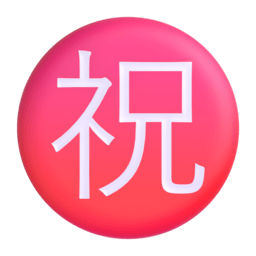㊗️
㊗️ Circled Ideograph Congratulation
Unicode: U+3297, U+FE0F
Description
Translated from Japanese, this means "congratulations" or "pray for happiness".
Image Variants

3D
Color
Flat
High Contrast
Version Information
Emoji Version:1.0
Unicode Version:1.1
Keywords
“congratulations”ideographJapaneseJapanese “congratulations” button祝
Shortcodes
| Platform | Shortcode | Action |
|---|---|---|
| Emojipedia | :japanese_congratulations_button: | |
| GitHub | :congratulations: | |
| Slack | :congratulations: | |
| Discord | :congratulations: |
Additional Information
Category:Enclosed CJK Letters And Months -> Circled ideographs
Definition:
Translated from Japanese, this means "congratulations" or "pray for happiness". Japanese “congratulations” Button was approved as part of Un http://emojipedia.org/circled-ideograph-congratulation/
Adjectives:
- Of or relating to or characteristic of Japan or its people or their culture or language
- Japanese
- Of or relating to Japan.
- Of, relating to, or derived from Japan, its language, or culture.
- Of or pertaining to China or its peoples or cultures
- Of China, its languages or people
- Of or relating to China, peoples from China or their languages.
- Relating to China.
Nouns:
- An agent in a work of art, including literature, drama, cinema, opera, etc
- A fictional character in a cartoon.
- A character is a person in a narrative work of arts.
- An imaginary person represented in a work of fiction (play or film or story)
- Fictional person in a narrative work of arts (for human fictional character use Q15632617)
- Language
- A Sino-Tibetan language spoken mainly in China and the surrounding regions and countries.
- P t?s?), tribal leaders recognized or appointed by the Chinese over nearby peoples
- Writing system of Chinese.
- The logographic writing system shared by this language family.
- Any of the Sino-Tibetan languages spoken in China; regarded as dialects of a single language (even though they are mutually unintelligible) because they share an ideographic writing system
- Chinese is a group of related but in many cases mutually unintelligible language varieties, forming a branch of the Sino-Tibetan language family.

